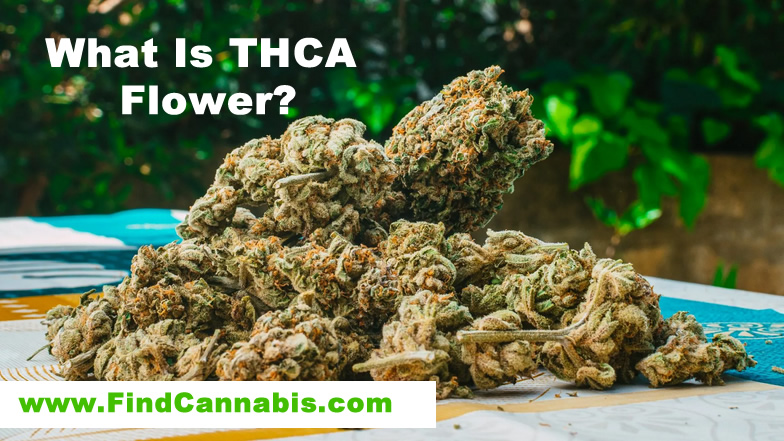The cannabis industry has witnessed remarkable growth and innovation in recent years, with consumers becoming increasingly sophisticated in their understanding of different cannabinoids and their unique properties. Among the most intriguing developments is the rising popularity of THCA flower, a raw cannabis product that offers distinct benefits without the psychoactive effects traditionally associated with marijuana. Understanding the science behind THCA flower reveals why this cannabinoid is capturing the attention of both researchers and consumers seeking alternative wellness solutions.
What is THCA Flower?
THCA (tetrahydrocannabinolic acid) flower represents cannabis in its most natural, unprocessed state. Unlike THC
(tetrahydrocannabinol), which produces the characteristic “high” associated with marijuana, THCA is the nonpsychoactive precursor found in fresh, raw cannabis plants. This acidic form of THC exists abundantly in living cannabis plants and only converts to psychoactive THC through a process called decarboxylation, which occurs when cannabis is exposed to heat, light, or time.
The distinction between THCA and THC is crucial for understanding the unique properties of THCA flower. While both compounds share similar molecular structures, the presence of a carboxyl group in THCA prevents it from binding effectively to CB1 receptors in the brain, which are responsible for psychoactive effects. This molecular difference makes THCA flower an attractive option for individuals seeking potential therapeutic benefits without cognitive impairment.
THCA flower typically contains high concentrations of this acidic cannabinoid, often ranging from 15% to 25% or higher, depending on the strain and cultivation methods. The flower maintains its THCA content when stored properly at cool temperatures and away from direct light, preserving its non-psychoactive properties until intentionally activated through heating.
The Molecular Science of THCA
The molecular structure of THCA provides fascinating insights into its unique properties and potential benefits. THCA’s chemical formula is C22H30O4, featuring a carboxyl group (-COOH) attached to the THC molecule. This additional carboxyl group significantly alters the compound’s behavior within the human body, affecting how it interacts with the endocannabinoid system and other biological pathways.
Research conducted by cannabis scientists has revealed that THCA exhibits a completely different pharmacological profile compared to its decarboxylated counterpart, THC. Studies published in peer-reviewed journals demonstrate that THCA interacts with various receptor systems beyond the traditional cannabinoid receptors, including TRPA1 and TRPM8 channels, which are involved in pain perception and temperature regulation.
The decarboxylation process that converts THCA to THC involves the removal of the carboxyl group through heat application, typically occurring at temperatures around 220°F (104°C) or higher. This thermal conversion explains why smoking, vaping, or cooking cannabis activates its psychoactive properties, while consuming raw THCA flower does not produce intoxicating effects.
Recent analytical chemistry research has also identified that THCA demonstrates greater stability in acidic environments compared to THC, suggesting potential advantages for certain delivery methods and formulations. This stability profile contributes to THCA flower’s shelf life and storage characteristics, making it an increasingly viable option for long-term use.
Potential Health Benefits of THCA Flower
Scientific investigation into THCA’s therapeutic potential has revealed several promising areas of application, though research remains in early stages and more clinical studies are needed to fully understand its effects. Preliminary research and anecdotal evidence suggest that THCA flower may offer various health benefits without the psychoactive concerns associated with traditional cannabis consumption.
Anti-Inflammatory Properties
Laboratory studies have demonstrated that THCA exhibits significant anti-inflammatory activity, potentially rivaling or exceeding that of THC in certain contexts. Research indicates that THCA may help modulate inflammatory responses through multiple pathways, including the inhibition of cyclooxygenase (COX) enzymes and the reduction of pro-inflammatory cytokines. These antiinflammatory properties suggest potential applications for conditions characterized by chronic inflammation, such as arthritis, inflammatory bowel disease, and certain autoimmune disorders.
The anti-inflammatory effects of THCA appear to be dose-dependent, with higher concentrations showing more pronounced effects in laboratory settings. This dose-response relationship
provides valuable information for developing standardized THCA flower protocols and dosing guidelines for therapeutic applications.
Neuroprotective Potential
Emerging research suggests that THCA may possess neuroprotective properties, offering potential benefits for neurological conditions and brain health. Studies using cellular models have shown that THCA can help protect neurons from oxidative stress and inflammation, two key factors in neurodegenerative diseases such as Alzheimer’s disease, Parkinson’s disease, and multiple sclerosis.
The neuroprotective mechanisms of THCA appear to involve multiple pathways, including the activation of antioxidant enzymes and the modulation of microglial activation. These findings have generated significant interest among researchers studying potential cannabinoid-based therapies for neurological disorders, though human clinical trials are still needed to confirm these effects.
Antiemetic Effects
Research has indicated that THCA may help reduce nausea and vomiting, similar to other cannabinoids but through different mechanisms. This antiemetic potential makes THCA flower particularly interesting for individuals undergoing chemotherapy, experiencing motion sickness, or dealing with other conditions that cause persistent nausea.
The antiemetic effects of THCA appear to be mediated through interactions with serotonin receptors and other neurotransmitter systems involved in nausea regulation. This multi-target approach may provide advantages over single-mechanism antiemetic medications, potentially offering more comprehensive symptom relief.
Potential Anti-Cancer Properties
Preliminary laboratory research has explored THCA’s potential anti-cancer properties, revealing promising results in cellular studies. Some research suggests that THCA may help inhibit cancer cell proliferation and promote apoptosis (programmed cell death) in certain cancer cell lines, particularly prostate cancer cells.
While these findings are encouraging, it’s important to emphasize that cancer research involving THCA remains in very early stages, and human clinical trials are necessary to determine actual therapeutic efficacy. The anti-cancer research represents one of the most active areas of THCA investigation, with several research institutions conducting ongoing studies.
Methods of THCA Flower Consumption
Understanding the various consumption methods for THCA flower is essential for maximizing its potential benefits while maintaining its non-psychoactive properties. Each consumption method affects bioavailability, onset time, and duration of effects, allowing users to choose approaches that best suit their individual needs and preferences.
Raw Consumption
The most straightforward method of consuming THCA flower involves eating it raw, either directly or incorporated into foods and beverages. Raw consumption preserves the full THCA content without any decarboxylation, maintaining the non-psychoactive properties while delivering potential therapeutic benefits. Many users incorporate small amounts of raw THCA flower into smoothies, salads, or other uncooked foods.
Raw consumption typically requires larger quantities compared to activated cannabis products due to lower bioavailability through the digestive system. However, this method allows for sustained release of THCA over several hours, potentially providing longer-lasting effects for certain applications.
Juicing
Fresh cannabis juicing has gained popularity as a method for consuming high concentrations of THCA and other raw cannabinoids. Juicing fresh THCA flower provides a concentrated source of cannabinoids, terpenes, and other plant compounds while maintaining their acidic, nonpsychoactive forms.
The juicing process requires fresh, recently harvested cannabis material to maximize THCA content and nutritional value. Many users combine cannabis juice with other vegetable or fruit juices to improve palatability and enhance the overall nutritional profile of the beverage.
Tinctures and Extracts
THCA tinctures and extracts offer precise dosing and convenient administration while preserving the nonpsychoactive properties of the cannabinoid. These products typically use extraction methods that avoid heat and maintain the acidic form of THCA, often utilizing CO2 extraction or cold ethanol processes.
Sublingual administration of THCA tinctures may provide faster onset compared to oral consumption, as the cannabinoids can be absorbed directly through the mucous membranes under the tongue. This method typically produces effects within 15-30 minutes and may offer improved bioavailability compared to digestive tract absorption.
Topical Applications
THCA flower can be processed into topical preparations such as salves, balms, and creams for localized application. Topical THCA products may provide anti-inflammatory and analgesic effects directly at the application site without any systemic psychoactive effects, even if some decarboxylation occurs during processing.
The development of topical THCA products represents an growing area of interest for addressing localized pain, inflammation, and skin conditions. Research into transdermal delivery of cannabinoids continues to evolve, with new formulations designed to enhance penetration and efficacy.
Legal Considerations and Regulations
The legal status of THCA flower exists in a complex regulatory landscape that varies significantly between jurisdictions and continues to evolve as lawmakers and regulators develop frameworks for different cannabis compounds. Understanding these legal considerations is crucial for both consumers and businesses operating in the cannabis industry.
In many jurisdictions, THCA itself is not explicitly scheduled as a controlled substance, as legal frameworks typically focus on THC content rather than its acidic precursor. However, the legal interpretation of THCA can vary, and some jurisdictions may consider THCA flower to be equivalent to marijuana due to its potential for conversion to THC.
The 2018 Farm Bill in the United States created a legal distinction for hemp-derived products containing less than 0.3% delta-9 THC by dry weight, which has led to some interpretations that high-THCA hemp flower may be legally permissible under federal law. However, this interpretation remains contested, and different states have implemented varying regulations regarding THCA products.
Many states with legal cannabis programs include THCA in their total THC calculations, effectively regulating THCA flower under the same framework as traditional marijuana products. This approach recognizes the potential for THCA conversion to THC and treats the acidic cannabinoid as equivalent for regulatory purposes.
The evolving legal landscape requires consumers and businesses to stay informed about local and federal regulations, as laws continue to develop and change. Consulting with legal professionals familiar with cannabis law is advisable for anyone considering commercial involvement with THCA products.
Quality and Safety Considerations
Ensuring the quality and safety of THCA flower requires careful attention to cultivation practices, processing methods, testing protocols, and storage conditions. These factors significantly impact the final product’s cannabinoid profile, purity, and potential therapeutic value.







